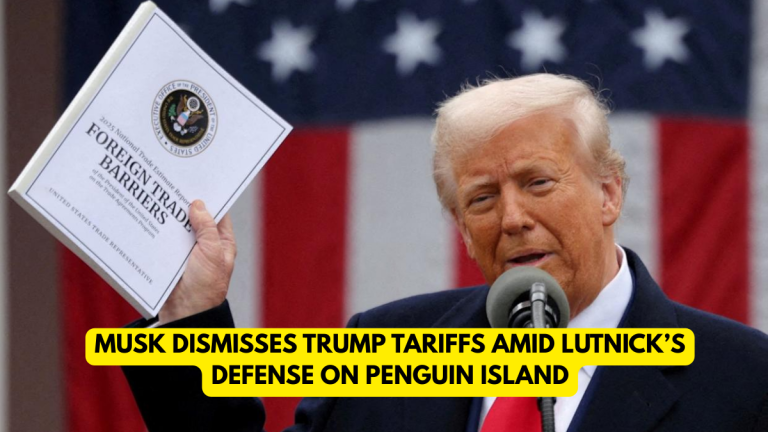
Former President Donald Trump is making headlines again—not just for his 2024 presidential campaign but also for the way he is framing U.S. economic history to justify his policies. Critics argue that Trump is “rewriting” history by selectively invoking America’s past to support a protectionist economic agenda, particularly one centered around tariffs.
But is this a revision of facts or a reimagining of history to suit present goals?
Trump’s Tariff-Focused Economic Plan
Donald Trump has long touted tariffs as a cornerstone of American economic greatness. In recent speeches and interviews, he has defended sweeping tariffs as necessary tools to restore the U.S. economy, reduce trade deficits, and bring back manufacturing jobs.
In fact, Trump has proposed a universal 10% tariff on all imports and even steeper tariffs on specific countries like China, aiming to reduce the U.S. trade deficit and incentivize companies to produce goods domestically. His 2024 campaign continues to champion these policies, branding them as part of a larger effort to restore America’s economic independence.
“Tariffs will bring manufacturing back,” Trump recently stated. “They built our nation once—and they will do it again.”
While this position has resonated with some American workers and industries, many economists argue that tariffs often increase consumer prices and can lead to retaliation from trade partners, as seen during Trump’s first term.
Reimagining the Gilded Age

To justify his stance, Trump often references the Gilded Age (1870s–1900)—a period of rapid economic growth during which the U.S. government employed high tariffs to protect domestic industries. During this era, American manufacturers benefited from government-imposed trade barriers that made foreign goods more expensive.
However, historians caution that the Gilded Age wasn’t the golden era that Trump portrays. While industrial production surged, the wealth gap widened, working conditions were often brutal, and financial crises were frequent.
According to AP News, Trump’s idealization of this era ignores the hardships faced by many Americans, including labor exploitation and a lack of safety nets. “It was a great time for the rich,” said one economic historian. “But not for the many.”
Nostalgia vs. Economic Reality
Experts say Trump’s selective interpretation of history is less about accuracy and more about narrative control. By drawing a straight line from historical tariffs to present-day prosperity, Trump positions his economic strategy as a continuation of America’s successful past.
As detailed in Vox, this strategy leans heavily on economic nostalgia—the belief that restoring past economic policies will lead to future greatness. However, today’s globalized economy is vastly different from the industrial America of the 19th century.
Modern supply chains, international trade agreements, and digital economies complicate any attempt to return to a purely protectionist model. Economists warn that overly simplistic historical comparisons can mislead the public and distort policymaking.
Economic Impact of Trump’s Tariff Legacy
During Trump’s first term, tariffs sparked a trade war with China, resulting in retaliatory tariffs on U.S. goods, particularly agricultural exports. According to a U.S. Department of Agriculture (USDA) report, farmers were hit hard, prompting the federal government to issue billions in subsidies to offset losses.
Meanwhile, the U.S. International Trade Commission (USITC) reported that American consumers paid higher prices for goods such as washing machines, steel, and aluminum due to tariff-induced price hikes.
Despite this, Trump maintains that the long-term benefits outweigh the short-term costs. “Short-term pain, long-term gain,” he declared during a recent campaign rally.
What Economists Are Saying?
Most mainstream economists disagree. The Tax Foundation, an independent tax policy think tank, has argued that Trump’s tariffs reduced GDP growth and employment during his first term. Read their analysis here.
Likewise, a study by the Federal Reserve Bank concluded that U.S. manufacturers saw mixed results from the tariffs: while some sectors gained, others—especially those dependent on imported components—suffered.
“There’s a cost to protectionism,” said one Fed economist. “It’s rarely a one-sided victory.”
A Divided Response
Public opinion is split. Some blue-collar workers and industries continue to support Trump’s hardline trade stance, viewing it as a bold corrective to globalization. Others, including small business owners and economists, warn that such policies are outdated and harmful in a complex global economy.
Critics also point out the danger of rewriting history to fit political goals. “It’s one thing to learn from history,” said a professor of economic history at Princeton University. “It’s another to cherry-pick it.”
The Bottom Line
As Trump continues to shape his economic message for 2024, it’s clear that history will be a central battleground—not just as a lesson from the past, but as a weapon for the future. Whether this rewriting of history will lead to electoral success or economic resurgence remains to be seen.
What is certain, however, is that Trump’s version of U.S. economic history tells a story that many experts say is incomplete—and potentially misleading.



